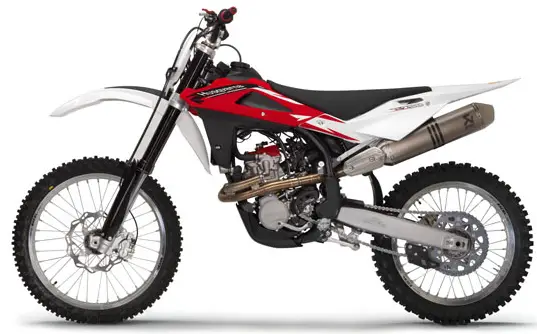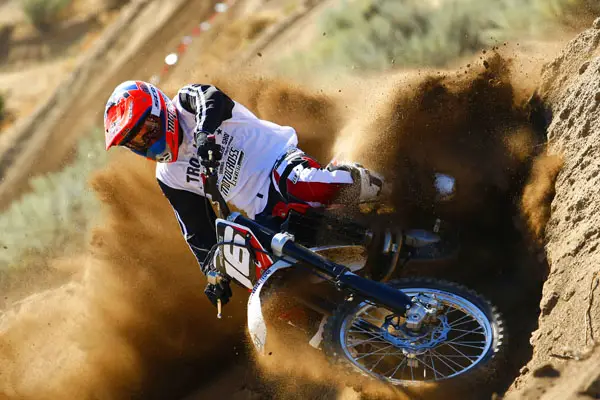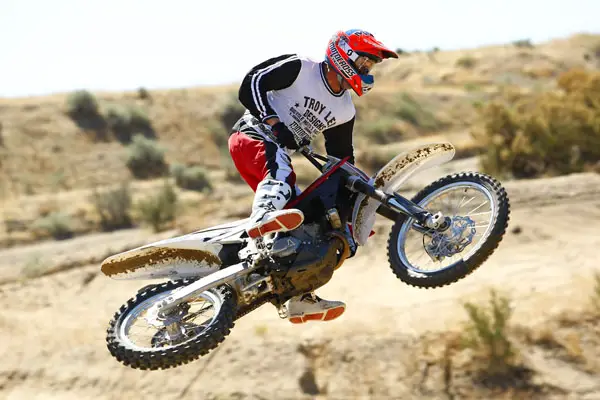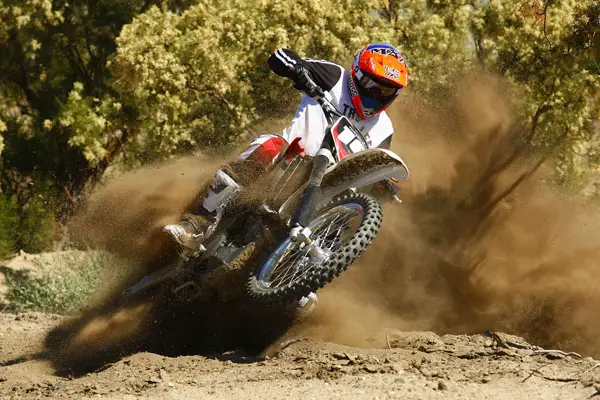2012 MOTOCROSS RACING IMPRESSION: SPENDING A DAY ON THE 2012 HUSQVARNA TC250

By John Basher
OUR LOVE/HATE RELATIONSHIP WITH THE TC250
The MXA wrecking crew has had a whirlwind romance with the Husqvarna TC250. Much of our experience on the 250 four-stroke should be considered troubled, with only minor glimpses of pure joy and adulation. Nevertheless, MXA test riders have grown to appreciate what the once Swedish, now German-owned Italian manufacturer (confused yet?) has done.
Husqvarna has made strides to better the TC250, albeit they have gone against the grain as to what has been considered common on other 250 four-strokes. Need examples?
Fuel injection: In 2011 Husky took the plunge into the world of electronic fuel injection, only instead of using a tried-and-true Keihin throttle body, they used Mikuni.
Suspension: After switching to Kayaba forks in 2010, they still used a Sachs shock.
Exhaust: The bike has a trick Akrapovic exhaust system…that sweeps to the left side instead of the right.
X-Lite: And the “X Lite” engine? It’s an engineering marvel, allowing enough room between the top of the engine and the gas tank for an eagle to nest. However, the most obvious difference between the TC250 and all other 250Fs comes in body styling. The minimalistic use of plastic, coupled with the wide rear fender and shark fin plastic molding at the top of the gas tank, equate to a uniquely different bike.
Truth be told, the MXA wrecking crew has bagged on the Husqvarna TC250 in years past. It was an easy target. Marked by an extremely slow engine, an odd suspension setup, and (up until two years ago) a carburetor that was finicky. The carburetor was so poorly jetted upon starting that most test riders resorted to finding a hill and bump-starting the bike. It became a matter of strategizing where to park in the pits (on a hill and away from teasing friends). The Husky TC250 was the Yugo in motorcycle form.
All of this leads to our first riding impression of the 2012 Husqvarna TC250. This past week the contingent of American Husky employees invited the MXA wrecking crew out to “The Ranch,” a motocross track in Anza, California. The bike launch was on September 8, 2011. Why is this date so important? In years past Husqvarna had been months behind every other manufacturer in releasing new bikes. September 8th was a groundbreaking date in Husky’s history. Normally we would have seen the new models in March or April or 2012. That’s no longer the case. Bravo!
A HOST OF REVISIONS

The 2012 TC250 isn’t a warmed over 2011 model. The 250 four-stroke boasts a new piston, cylinder head, Kayaba shock, frame reinforcements, in-mold graphics and Keihin EFI system.
Let it be known that Husqvarna had their whole line of offroad bikes at our disposal, including the TC449. Without blatantly snubbing the TC449, we were far more interested in riding the 2012 Husqvrana TC250. Why? Between the two bikes, the TC250 received a significantly greater number of major updates. Husky drop-kicked the Mikuni throttle body for a Keihin D42 system, went to a Kayaba shock (in place of the Sachs), upgraded to a CDI programmable ignition (with three preset maps), and made several key revisions to the engine. The TC250 has a new piston that’s lighter and freer-revving (and based on F1 technology). The cylinder head has been redesigned, and the valve finger followers are now DLC-coated for durability.
Other changes came in the chromoly-reinforced frame (it’s now black instead of white and has increased rigidity and strength). The Akrapovic exhaust comes with a resonance chamber on the headpipe, the Excel rims are now silver instead of black, the suspension has revised damping settings, and the airbox and velocity stack have been revised for improved top-end engine performance.
The “X Lite” engine has been “enemy number one” for the MXA wrecking crew in the past. On previous models the TC250 had a very flat power profile that really couldn’t get out of its own way. There wasn’t a hint of personality, and without pulling any punches, the bike felt like there was a rag in the airbox. On the dyno the results confirmed our opinions on the track (although we couldn’t find the rag). To try and make silk, we geared the TC250 down, tried different aftermarket exhaust systems and nearly resorted to voodoo before throwing up our hands. To their credit, Husqvarna knew that the TC250 was lacking in the power department, which is why they focused heavily on making changes to that area on the 2012 model.
Excited by the prospects of the new engine changes, we cornered Husqvarna’s development crew and asked what kind of horsepower gains were made on the 2012 TC250. Their reply? Six horsepower. Often we like to give the benefit of the doubt?but six horsepower? It was hard to believe, given that the old engine pumped out roughly 34 horsepower. We’ll chalk the hyperbole up to Husqvarna trying to get us revved up to ride the 2012 TC250 (and that the fact that there are many places on the power curve where the TC250 could gain six hoursepower over the old model?just not at peak).
ON THE TRACK: TWIST AND GO

Dennis Stapleton rips a turn at “The Ranch” on the EFI Keihin-equipped, Italian-designed, F1-inspired Husqvarna TC250.
Husqvarna’s move towards normality on the 2012 TC250 signified an understanding and appreciation for technology that the Big Five manufacturers have been using for years. After all, Husky wants to join the party and enter in what will eventually be referred to as the “Big Six.” Is Husqvarna getting closer to their goal of having a competitive 250 four-stroke? Yes. In a single model year Husky has targeted the various woes of their machine and addressed them by making changes. Instead of turning a deaf ear and discounting their critics, they are facing the music.
That realization came full circle after a few laps on the 2012 TC250. It’s not just marginally better than any previous TC250 model?it’s remarkably better. While it still feels like the same motorcycle (the frame geometry, handlebars, seat height, grips, levers and dimensions of the cockpit weren’t touched), this is a good thing. The MXA wrecking crew has long praised the TC250 for its ergonomics and handling traits. Test riders were able to navigate corners with precise control and hit their marks in ruts, berms and flat corners. Tractability was excellent, thanks in part to the chromoly frame, but also because of the revamped powerband.

Upon first ride the 2012 TC250 opened our eyes. The engine is quite a bit more powerful than in years past, and the handling is precise.
We can’t, in good conscience, agree with Husqvarna that the TC250 was bolstered by six horsepower. Why? In no way is the 2012 model a rocket ship. We figured that, like on the older generation KTM 250SXF engine (which was a rocket ship), peak horsepower would be hidden at an extremely high rpm (around 13,000 rpm). We figured wrong. The TC250 revved freely, but it signed off well before it hit the stratosphere. Hence, we have to wonder where the six horsepower is hidden. We’re not broken up about it, though. This is the best TC250 engine that Husqvarna has ever produced. The lighter piston allows the bike to rev much faster, the revised cylinder head picks up the power quicker, and the Keihin EFI system seemed to deliver fuel with far more efficiency than the Mikuni EFI (and don’t get us going on the old carb, because we’ve spent several years in counseling and have finally rounded the turn). As for the DLC-coated finger followers, we’re of the opinion that finger followers are a brilliant technology for motocross. They greatly improve durability over the valve-and-bucket system (which all of the Japanese manufacturers use).
It took a few years, but the MXA wrecking crew eventually came to enjoy the Swedish-built Sachs shock. The shock performed unlike a Showa or Kayaba unit, in that it felt much more springy, loose and caused the rear end to wallow under heavy loads. Lighter and smaller riders didn’t mind these sensations, but heavier and faster riders felt that the Sachs shock blew through the stroke too quickly and often bottomed out. Many testers were pleased to learn that Husqvarna switched to a KYB unit for 2012. Logically it made sense for Husky to go this route. They had gone from Marzocchi forks several years ago to 48mm Kayaba AOSS units in 2010. Pairing KYB forks with a Sachs shock was, for lack of a better word, cheesy. Now the TC250 has uniform suspension, and the performance advantage is noticeable. The bike feels much more planted, straight line stability is improved, and the valving is stiffer. Be gone, pogo stick!
WHERE DO WE GO FROM HERE?

We expect to get our hands on the 2012 TC250 in mid-November so that we can begin an extensive test.
Although we learned quite a bit in the few hours that we rode the 2012 Husqvarna TC250, we need a lot more saddle time to really dissect the bike. That isn’t going to happen immediately, because the bike we rode for this impression is one of handful in the country now. Husky hinted that the TC250 would hit U.S. shores in mid-November, at which point we should begin our typically long shake down cruise on the TC250.
Bear in mind that during our one-day Husqvarana impression, we didn’t make clicker adjustments, mapping changes, try different gearing or adjust fork height. There’s a long road ahead before we come out with the full-blown bike test in the magazine, but know that Husqvarna has done their homework for 2012. The TC250 isn’t a world beater, but it is vastly improved. We foresee that it can be a competent racing machine in the right hands.
The 2012 Husqvarna TC250 retails for $6999. For more information, visit www.husqvarna-motorcyclesna.com.





Comments are closed.